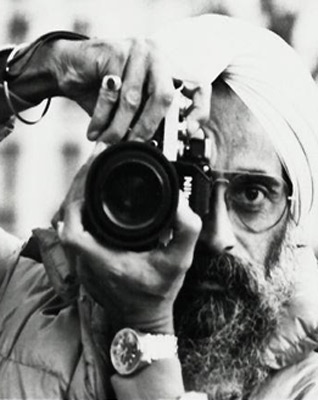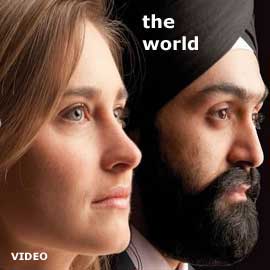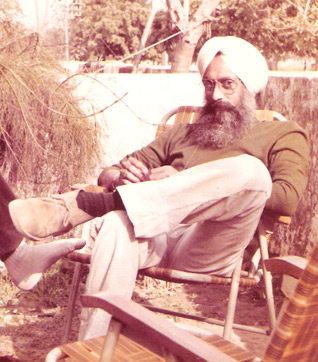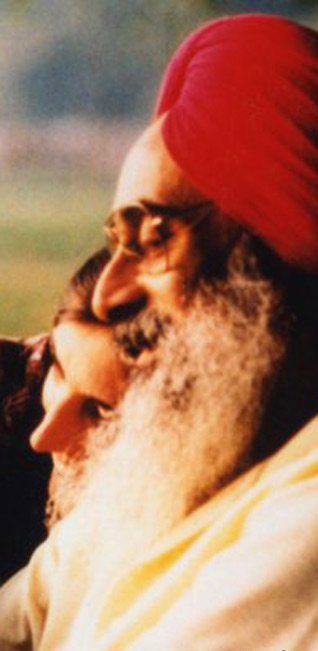People
A Rendezvous in Paris ...
With Naresh Singh
HARDEV SINGH VIRK
I entered the portals of Paris University, France towards the end of October, 1970 after winning a French Government scholarship.
At that time I was the only turbaned Sikh in the Marie and Pierre Curie University of Paris.
Just as they are still today, the French were intolerant of other faiths and their articles of faith, especially the turban.
For a few days, I was not allowed to dine in the International House (Cite′ Universitaire) and the French students used to chant in rhyme, ‘chapeau, chapeau’ as soon as I entered. They took my turban as a sort of chapeau (hat), the wearing of which -- in a public but indoor place -- is considered inappropriate, according to French custom.
Other than that, as a Sikh I was liked by all and called and treated like a ‘Maharaja’ in the University circuit.
One day, while I was coming out of the scholarship office in Paris, I was suddenly stopped by a lady addressing me as “Mr. Singh“.
She was Marianne who introduced me to a smart-looking Sardar, Naresh Pal Singh, who was her husband. Marianne told me that Naresh feels bored in Paris and it will be nice if we could start meeting at frequent intervals. I accepted the invitation and after a few meetings, we both became good friends.
I discovered that Naresh belonged to Nilokheri’s famous Butalia family which served in the Khalsa army of Maharaja Ranjit Singh and was given liberal land grants for its service to the Sikh Kingdom.
As planned, our meetings were quite frequent. Later on, Naresh also joined my university as a student of Marine Biology. It was merely his pastime; he did not take his studies seriously.
One evening, while I was returning to my hostel, Naresh introduced me to his friend, Catherine, who was interested in the study of Sikh religion. She asked many questions about Sikhi.
Soon thereafter, Naresh, Catherine and an older lady, Anne Marie Maison, visited my hostel. Over a cup of tea, we had a discussion about starting some activity to promote Sikhi in Paris. Those were days when hippie culture was at its peak in Europe and ‘yogis’ from the subcontinent had their heyday in the western hemisphere.
The same evening, we visited Ramakrishna Mission Ashram at Gretz, near Paris. The Swami treated us well and delivered his sermon to the audience consisting of mostly French men and women interested in Hinduism.
After this visit, Anne Marie Maison proposed that a gurdwara needed to be started in Paris. She offered her house for the purpose of weekly congregations. I was busy with my doctoral thesis and did not avail of her offer. There was hardly any Sikh presence in France during the 1970s. Once in a while, I met some Punjabi boys who were refugees and wannabe immigrants and wanted to cross the English Channel to reach England.
During my sojourn in Paris, my meetings with Naresh were almost a regular feature. He became a father of two very bright and pretty daughters and his wife, Marianne, often invited me for dinner parties. Naresh always insisted on driving me back to my hostel even if it was midnight, despite Marianne who’d rather I headed home on my own on the Metro. He would explain that Marianne had become very possessive after her motherhood.
For whatever reasons, the couple parted company not long after and Naresh developed an intimate relationship with Catherine and started sharing a home with her. In fact, Catherine was also serving as a model for Naresh, who had by now become a world renowned photographer. He was also a photo-artist of nude portraits.
I returned to India in November 1972. Our correspondence continued almost uninterrupted and Naresh regularly wrote about his exhibitions of art photographs in galleries around the world. I participated in his show at Max Mueller Bhawan, New Delhi.
During my research trips to Europe, I always made it a point to visit Naresh in Paris. He always put himself at my disposal and took care of my personal needs.
When Catherine fell sick and died, he became extremely sad and wrote me that life had no charm left for him.
During an exhibition, he met Sabine. They fell in love and his zest for life returned with full gusto. He set up his home and studio in suburban Paris. They visited Punjab and both of them stayed in Amritsar for a week.
During my last visit in 2001, I found Naresh and Sabine living happily together. I retired from Guru Nanak University, Amritsar in June 2002. In October 2003, I called Naresh from London to tell him about my forthcoming visit to Paris.
Sabine answered my call and told me in a sad voice that Naresh was no more in this world! He had succumbed to a sudden heart attack.
How could I visit Paris in the absence of my friend, Naresh?
In 2009, I participated in an international conference in Padua, Italy and visited various gurdwaras in Italy and France. The Sikh presence in Europe has blossomed now, far exceeding even my imagination.
I called Sabine from the Paris gurdwara but she was unable to get together. However, she told me that she visited the gurdwara once in a while with her daughter Amrita to ensure that Amrita felt related to the Sikh faith of her father.
Naresh died leaving three beautiful Sikh daughters in this world. I am in touch with each of the three by e-mail to keep alive fond memories of my friend from Nilokheri and Paris.
May 10, 2013
Conversation about this article
1: Kirpal Singh (Daytona Beach, Florida, U.S.A.), May 10, 2013, 9:19 PM.
Beautiful story. I wish these families can be integrated into Sikh society permanently.
2: Kanwarjeet Singh (USA), May 15, 2013, 10:45 PM.
Beautiful! Sikhs - the amazing race! On a separate note: the author strikingly resembles Prof. Darshan Singh ji from his photos in the 1990s.
3: Decaens Singh (France), June 26, 2016, 4:55 AM.
Thank you, Hardev for these words ... Amrita is so happy to read something about her father. God bless you. Sabine.
4: Hardev Singh Virk (Mohali, Punjab), September 20, 2016, 7:38 PM.
Swaran Singh Kahlon is working on his book: "Sikhs in Europe". He has collected information about Naresh's life and work in Paris. I look forward to reviewing his book when published. Kanwarjeet: my photo as author was shot at the Dead Sea, Israel in 2005. Sabine: I would like to see Amrita during my next visit to Paris.






